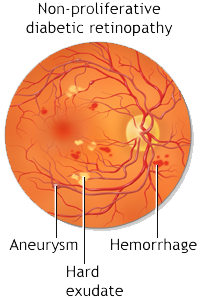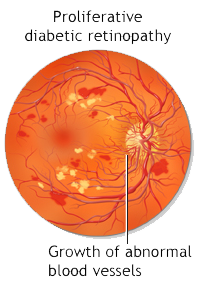You are here
Diabetic Retinopathy
What is Diabetic Retinopathy?
Diabetic retinopathy is a complication of diabetes. This complication affects the retina of the eye and can lead to blindness. The longer a person has diabetes, the greater the chance of developing diabetic retinopathy. People who developed diabetes during childhood are most at risk of being stricken with diabetic retinopathy.
Types of Diabetic Retinopathy
There are two types of diabetic retinopathy – nonproliferative (also called background) retinopathy and proliferative retinopathy.
- Nonproliferative (Background) Retinopathy - Nonproliferative retinopathy causes the blood vessels in the retina to change diameter. Some blood vessels shrink while others swell. This random change in diameter affects blood flow to the retina. This variance of blood flow can also affect other areas of the eye - some areas do not get enough blood while other areas hemorrhage.
Nonproliferative retinopathy usually does not negatively affect vision and usually does not worsen over time. But left unmonitored, nonproliferative retinopathy can damage the eye. Nonproliferative retinopathy can be a predecessor of proliferative retinopathy, which is a far more serious form of diabetic retinopathy.
- Proliferative Retinopathy - Proliferative retinopathy occurs when areas of the retina do not receive enough blood. The affected retinal tissue produces molecules and these molecules cause new blood vessels to grow near the retina’s surface. These new blood vessels can break and leak blood into the vitreous (the clear fluid that fills the eye). As blood leaks into the vitreous, the normally clear fluid of the vitreous becomes cloudy. Light cannot pass through the vitreous to the retina. Because light cannot get to the retina, vision is blurred. If the light to the retina becomes completely blocked, blindness occurs. The leaking blood vessels can form scar tissue. If this scar tissue pulls at the retina, retinal detachment can occur. Retinal detachment is very serious and will lead to blindness if not treated immediately.
In addition to retinal detachment, proliferative retinopathy can lead to other serious eye problems such as glaucoma.


Risk Factors
People with diabetes can greatly reduce their risk of developing diabetic retinopathy by having routine eye exams with an ophthalmologist. Patients should be certain to inform their ophthalmologist about their medical condition and any vision problems or vision changes they experience, no matter how minor or fleeting they may seem. Anyone with diabetes can develop diabetic retinopathy, the risk factors listed below may increase a persons chance of developing diabetic retinopathy
- The longer you have diabetes, the greater your risk of diabetic retinopathy
- Poor control of your blood sugar level
- High blood pressure
- High cholesterol
- Pregnancy
- Tobacco use
Symptoms of Diabetic Retinopathy

During the early stages of diabetic retinopathy, there are typically no symptoms. In fact, symptoms may not appear even after severe damage has already been done to the eye. Routine eye exams by a licensed ophthalmologist will detect diabetic retinopathy during its early stages, when treatment is most effective.
Although diabetic retinopathy usually has no symptoms, some diabetics who develop diabetic retinopathy report the following:
- Sudden onset of blurred or hazy vision
- Floaters in the field of vision
- Other abnormal patterns in the field of vision that suddenly appear

If you or a family member experiences any of these symptoms, or any other unusual or sudden change in vision, contact an ophthalmologist immediately. TLC Eyecare and Laser Centers has on call doctors 24 hours a day, seven days a week to serve your vision emergencies.
Diagnosis & Tests
The health care provider can diagnose diabetic retinopathy by dilating your pupils with eye drops and then carefully examining the retina. A retinal photography or fluorescein angiography test may also be used.
If you have nonproliferative diabetic retinopathy, your health care provider may see:
- Blood vessels in the eye that are larger in certain spots (called microaneurysms)
- Blood vessels that are blocked
- Small amounts of bleeding (retinal hemorrhages) and fluid leaking into the retina
If you have proliferative retinopathy, your health care provider may see:
- New blood vessels starting to grow in the eye that are fragile and can bleed
- Small scars developing on the retina and in other parts of the eye (the vitreous)
Treatment for Diabetic Retinopathy
Laser surgery is the most common form of treatment for diabetic retinopathy. The laser seals the blood vessels and stops their growth. This treatment improves vision and prevents further vision loss by helping reduce swelling of the retina and inhibiting new blood vessel formation in the retina. Laser surgery is a painless in-office procedure that can be done in less than 30 minutes.
Laser surgery is not effective once the vitreous is clouded with blood. For these cases, a vitrectomy is performed. A vitrectomy procedure removes the clouded vitreous and replaces it with a clear artificial solution such as saline (salt water). Carmelina Gordon, M.D. uses the most advanced diagnostic equipment available. She can detect and treat diabetic retinopathy in its very early stages before symptoms arise, preventing serious eye damage and loss of vision. If you suffer from diabetes, we want to help. Contact us today for more information or to schedule an appointment.
Home
......................................
Locations
......................................
Schedule Appointment
About
......................................
Press & Events
......................................
Testimonials
Retina Conditions
......................................
AMD - Macular Degeneration
......................................
Diabetic Eye Disease
......................................
Epiretinal Membrane
......................................
Macular Hole
......................................
Retinal Detachment
Research
......................................
Tools & Resources
......................................
Contact



